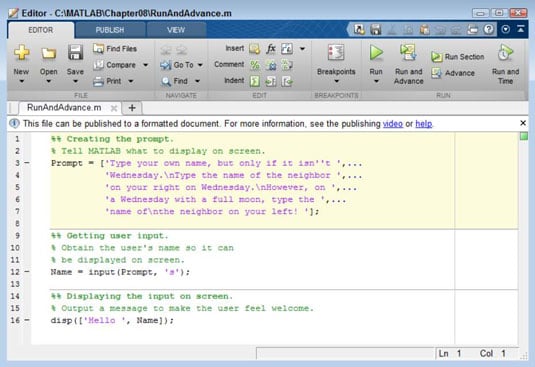

You can then connect your signals directly to the function without having to mux them together.

When you have 3 input variables for your function, you will notice that Simulink will create 3 input ports on your MATLAB function block. You could define your function as: function y = fcn(u1, u2, u3) What's nice about the MATLAB Function block is that you do not need to combine your inputs into a single mux before passing into the function call. Same for the input variable name, u, and output variable name, y. By using the Comment button in the Live Editor (Present as a ) 2. The name fcn is the default function name for the block, but you can rename that to whatever you want.
#MATLAB BLOCK COMMENT CODE#
The code in the MATLAB Function block is similar to how you would code a function using MATLAB scripting. If you're feeding a 3 element mux into the MATLAB Function block, the code that reproduces what you want is: function y = fcn(u) For this example, first let's create some *.The MATLAB Function block in Simulink is a little bit more powerful than the original Fcn block. Let's start with a simple problem and say we need to find a list of *.mat files given the folder. An applied function can either be anonymous, which is usually a case, or any regular function define in a *.m file. The idea is to take an array or cell class variable, loop through all its elements and apply a dedicated function on each element. This simple example provides an explanation on some functions I found extremely useful since I have started using MATLAB: cellfun, arrayfun. # Useful functions that operate on cells and arrays Then the graphics array can be saved using savefig like with a normal figure, but with the handle to the graphics array as an additional argument.Īn interesting side note is that the figures will tend to stay arranged in the same way that they were saved when you open them. This creates 3 scatterplots of random data, each part of graphic array h. H ( 1 ) = figure scatter ( rand ( 1, 100 ), rand ( 1, 100 ) ) h ( 2 ) = figure scatter ( rand ( 1, 100 ), rand ( 1, 100 ) ) h ( 3 ) = figure scatter ( rand ( 1, 100 ), rand ( 1, 100 ) ) savefig (h, 'ThreeRandomScatterplots.fig' ) close (h ) The following code creates an example figure that shows two lines a sin function and a threshold and a legend You can also block comment multiple lines of code. It turns out that the Line objects hold all data in following properties: XData, YData, and ZData the last one is usually 0 unless a figure contains a 3D plot. The leading characters // are added to the beginning of each line when commenting one or more lines of code. Once a line object has been found, get (opens new window) can return any value held by properties. findobj (opens new window) returns a handler to an object given attributes or properties of the object, such as Type or Color, etc. The key functions are findobj (opens new window) and get (opens new window).
#MATLAB BLOCK COMMENT HOW TO#
This example shows a trick how to achieve extract information from a figure. On a few occasions, I have had an interesting figure I saved but I lost an access to its data.

You will be able to fold sections to have a general overview of your Then instead of seeing a long source code similar to : Sections are delimitedĮxample: To enable it check the "Sections" box: block of comments in matlabmatlab commentsmatlab commentcomment shortcut matlabcomment shortcut in matlabcomment multiple lines matlabmatlab exclamation. Note that folding is persistent, in the sense that part of the code that has been expanded/collapsed will keep their status after Matlab or the m-file has been closed and is re-open.Īn interesting option is to enable to fold Sections.

spline-almost-block-diagonal-form or as a MATLAB sparse matrix. # Useful tricks # Code Folding Preferences I have a set of data and i want to use curve fit toolbox in matlab to plot a spline. Useful functions that operate on cells and arrays.Functional Programming using Anonymous Functions.Ordinary Differential Equations (ODE) Solvers.answers, and comments If the user input yes the program will run again. Fourier Transforms and Inverse Fourier Transforms Ask Question For mathematical questions about MATLAB questions purely about.


 0 kommentar(er)
0 kommentar(er)
